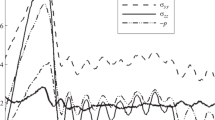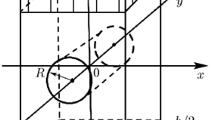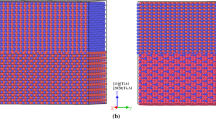Abstract
Results of numerical simulations of fracture of nanocrystals of the TiAl3 intermetallic compound by the molecular dynamics method are reported. The TiAl3 nanocrystals are subjected to uniaxial tension in a wide range of temperatures (300–1200 K). It is demonstrated that tension of nanocrystals of the TiAl3intermetallic compound heated approximately up to 1000 K first leads to a phase transition from the crystalline to liquid state, followed by fracture. Fracture of a heated TiAl3 nanowire is preceded by deformation in the superplasticity regime.





Similar content being viewed by others
REFERENCES
B. J. Henza, T. Hawa, and M. Zachariah, “Molecular Dynamics Simulation of the Kinetic Sintering of Ni and Al Nanoparticle," Molecular Simulat. 35 (10/11), 804–811 (2009).
L. Chang, C.-Y. Zhou, L.-L. Wen, et al., “Molecular Dynamics Study of Strain Rate Effects on Tensile Behavior of Single Crystal Titanium Nanowire," Comput. Materials Sci. 128, 348–358 (2017).
L. Chang, C.-Y. Zhou, H.-X. Liu, et al., “Orientation and Strain Rate Dependent Tensile Behavior of Single Crystal Titanium Nanowires by Molecular Dynamics Simulations," J. Materials Sci. Technol. 34, 864–877 (2018).
V. V. Pogorelko and A. E. Mayer, “Influence of Titanium and Magnesium Nanoinclusion on the Strength of Aluminum at High-Rate Tension: Molecular Dynamics Simulations," Materials Sci. Engng. A. 662, 227–240 (2016).
A. E. Mayer and P. N. Mayer, “Evolution of Pore Ensemble in Solid and Molten Aluminum under Dynamic Tensile Fracture: Molecular Dynamics Simulations and Mechanical Models," Intern. J. Mech. Sci. 157/158, 816–832 (2019).
C. Hui, R. Zhiyuan, C. Wence, et al., “Deformation Mechanisms in Nanotwinned \(\gamma\)-TiAl by Molecular Dynamics Simulation," Molecular Simulat. 44 (18), 1489–1500 (2018).
P. A. Zhilyaev, A. Yu. Kuksin, V. V. Stegailov, and A. V. Yanilkin, “Effect of Plastic Deformation on Aluminum Single Crystal Fracture under Shock Wave Loading," Fiz. Tverd. Tela 52 (8), 1508–1512 (2010).
S. P. Kiselev and E. V. Zhirov, “Molecular-Dynamics Simulation of the Synthesis of Intermetallic Ti–Al," Intermetallics49, 106–114 (2014).
S. P. Kiselev, “Method of Molecular Dynamics in Mechanics of Deformable Solids," Prikl. Mekh. Tekh. Fiz. 55 (3), 113–139 (2014) [J. Appl. Mech. Tech. Phys. 55 (3), 470–493 (2014)].
S. K. Godunov, S. P. Kiselev, I. M. Kulikov, and V. I. Mali, Modeling of Shock Wave Processes in Elastoplastic Materials at Different (Atomic, Meso-, and Thermodynamic) Structural Levels (Inst. Computer Research, Moscow, Izhevsk, 2014) [in Russian].
D. R. Kurran, “Dynamic Fracture," in Impact Dynamics (Mir, Moscow, 1985), pp. 257–293.
S. I. Ashitkov, M. B. Agranat, G. I. Kanel, et al., “Behavior of Aluminum near its Ultimate Theoretical Strength in Experiments with a Femtosecond Laser Action," Pisma v ZHETF 29 (8), 568–573 (2010).
S. I. Ashitkov, P. S. Komarov, E. V. Struleva, and M. B. Agranat, “Resistance of Titanium near its Theoretical Strength Limit to Deformation," Teplofiz. Vys. Temp. 56, 897–901 (2018).
S. P. Kiselev, “Numerical Simulation of Fracture of the Ti–Al Intermetallic Nanocrystal by the Molecular Dynamics Method," Dokl. Akad. Nauk 483 (6), 616–619 (2018).
S. J. Plimpton, “Fast Parallel Algorithms for Short-Range Molecular Dynamics," J. Comput. Phys. 117, 1–9 (1995).
R. R. Zope and Y. Mishin, “Interatomic Potentials for Atomistic Simulations of the Ti–Al Systems," Phys. Rev. B 68, 024102-1–024102-14 (2003).
S. P. Kiselev, “Modeling of Crystallization of the Ti–Al Nanoparticle by the Molecular Dynamics Method," Dokl. Akad. Nauk 466 (4), 406–408 (2016).
S. J. Nose, “Unified Formulation of the Constant Temperature Molecular Dynamics Methods," Chem. Phys. 81, 511–519 (1984).
S. P. Kiselev and V. P. Kiselev, “Numerical Simulation of Fracture of Titanium and Aluminum Nanocrystals by the Molecular Dynamics Method," Fiz. Goreniya Vzryva 57 (4), (2021) [Combust., Explos., Shock Waves 57 (4), (2021)].
Author information
Authors and Affiliations
Corresponding author
Additional information
Translated from Prikladnaya Mekhanika i Tekhnicheskaya Fizika, 2021, Vol. 62, No. 3, pp. 71-79. https://doi.org/10.15372/PMTF20210307.
Rights and permissions
About this article
Cite this article
Kiselev, S.P. NUMERICAL SIMULATION OF FRACTURE OF NANOCRYSTALS OF THE TiAl3 INTERMETALLIC COMPOUND BY THE MOLECULAR DYNAMICS METHOD. J Appl Mech Tech Phy 62, 411–418 (2021). https://doi.org/10.1134/S002189442103007X
Received:
Published:
Issue Date:
DOI: https://doi.org/10.1134/S002189442103007X




